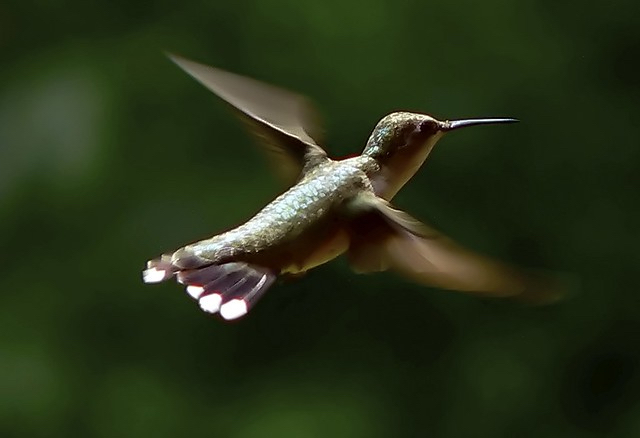
 As the most literal of helicopter parents, a ruby-throated hummingbird mom (RTH, Archilochus colubris) takes hovering to a whole new competitive level.
As the most literal of helicopter parents, a ruby-throated hummingbird mom (RTH, Archilochus colubris) takes hovering to a whole new competitive level. Both male and female RTHs winter in Central America or along the southern tip of Florida, but from the moment a gal returns to her summer stomping grounds in the eastern half of the US or southern Canada, she’s all go-go-go… because her biological clock is ticking like a stopwatch. Barely hesitating to catch her breath, the first order of business is to find a baby daddy. She’s not looking for ever-after; Mr. Right-for-Now will do as long as he’s strong and handsome. Since the males of her clan aren’t the slightest bit interested in becoming a Mr. Mom this arrangement suits everyone just fine. With barely a look backward by either party following their four-second assignation, he jets off to find another hookup, and she speeds away to shop for flower-down to line the bassinet.
Both male and female RTHs winter in Central America or along the southern tip of Florida, but from the moment a gal returns to her summer stomping grounds in the eastern half of the US or southern Canada, she’s all go-go-go… because her biological clock is ticking like a stopwatch. Barely hesitating to catch her breath, the first order of business is to find a baby daddy. She’s not looking for ever-after; Mr. Right-for-Now will do as long as he’s strong and handsome. Since the males of her clan aren’t the slightest bit interested in becoming a Mr. Mom this arrangement suits everyone just fine. With barely a look backward by either party following their four-second assignation, he jets off to find another hookup, and she speeds away to shop for flower-down to line the bassinet. ………………………and then just…
………………………and then just… Oh, and somewhere in that frantic schedule, this solo parent also needs to down enough calories to keep her own metabolism running on all cylinders.
Oh, and somewhere in that frantic schedule, this solo parent also needs to down enough calories to keep her own metabolism running on all cylinders. As befits a fast-paced life, in barely the blink of an eye (or the wing-beat of a hummingbird) summer is over. Male RTHs often head south first, in early August. Females tend to delay departure until late August or sometime in September. After months of feeding others—our feathered Supermom may have raised as many as three broods in a single season—the time has come to focus on self-care, and on building enough fat reserves to power through an 18-22 hour non-stop flight across the Gulf of Mexico.
As befits a fast-paced life, in barely the blink of an eye (or the wing-beat of a hummingbird) summer is over. Male RTHs often head south first, in early August. Females tend to delay departure until late August or sometime in September. After months of feeding others—our feathered Supermom may have raised as many as three broods in a single season—the time has come to focus on self-care, and on building enough fat reserves to power through an 18-22 hour non-stop flight across the Gulf of Mexico.